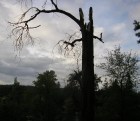(1) What is Folklore? –We know folklore best by its stories (legends, myths, fairy tales), but folklore also consists of jokes, sayings, games, songs, traditional practices (ranging from celebrations to manners of food preparation), clothing styles, housing decorations, and traditional crafts. In short, folklore is anything by which a social group expresses itself and its special traditions and cohesiveness as a group.
The concept of “social group” is a key one in the identification of folklore. An individual story is not “folklore” unless it is re-told among members of a social group. The definition of social group is a flexible one. There are a wide range of sizes and types of social groups. We have folklore of large national groupings such as American society, folklore of cultural groups within that larger, complex society (such as African-American or Irish American stories and songs), folklore of American children, folklore of particular families, folklore of various professional groups, even folklore of individual offices or factories. Every social group, no matter how large or small, will likely have shared stories, jokes, or practices that are the folklore of that group.
(2) How is Folklore Transmitted?–Among the Chehalis peoples (Native Americans of southwestern Washington with whom I worked), a story that was not properly attended to by its audience would simply be dropped from the traditional storytelling repertoire, never to be told again. Both the audience and the teller had separate responsibilities: the audience’s was to listen carefully to a story, the teller’s was to enliven that telling in a context-specific way. If there were white members of a Chehalis storytelling audience, for instance, a Chehalis storyteller might well shape the story so that whites appeared as actors within it. Concerning the audience, it was said that, whereas children might not fully understand a story when it was told, that story would “come back” to them at key points in their lives, when its true value would come to light. In the words of the Chehalis, “We know what our stories mean when it comes time for us to use them.”
These aspects of Chehalis storytelling illustrate some essential characteristics of the transmission of all folklore. Without a community which it belongs to and expresses, folklore is simply not folklore. This is one of the features that distinguishes folkloristic stories, for instance, from written short stories or novels. Folkloristic stories are inextricably linked to a social group and thus to a social interaction, as well. Folkloristic stories (especially in more traditional cultures) are performed as much as told, being carefully crafted to fit their audiences.
Let us now look more closely at four aspects of the process of folklore transmission. (Understanding the way in which folklore is transmitted will also help you to recognize folklore when you encounter it in contemporary society).
First, folklore is passed on in inter-personal ways. As in the Chehalis example above, folklore is always passed on between persons. In its most ancient sense, folklore is the passing on of traditional wisdom, the “conversation” between generations that makes us human.
Second, unlike written material, folklore is passed on in a way that is active and flexible, being adapted to its audience and their context. Folklore is thus constantly in process, constantly changing (whether a little or a lot).
Third, folklore is often inter-generational, although it may have a good deal more historical depth than this. Folklore has characteristically been formed over a number of generations of common social experience and interaction. In our own complex and rapidly changing society, however, the classic time depth of folklore may be modified. “Folklore from the paperwork empire,” (see “Performance Appraisal” and “Sick Leave Policy”), as Alan Dundes has termed folklore of the contemporary American workplace, may be passed from workplace to workplace as folklore and yet be quite “young” compared to traditional Chehalis stories, which express a traditional way of life ten thousand years old, or some of the European fairy tales collected by the Grimm brothers, which pre-date recorded history, or folklore of the Australian Aborigines which may express as much as 50,000 years of communal experience!
Finally, because folklore is always the folklore of a social group, it is always particularly accessible to that group. Folklore that does not easily pass from person to person simply does not survive as folklore. Folklore delights and engages, “captures,” its audience. The Chehalis acknowledge this necessary quality of folklore when they refuse to repeat stories which do not hold audience interest.
(3) What is the Difference between Folklore and Myth?–So far I have been using the inclusive term, “folklore,” in discussing the material of oral traditions. Let’s now distinguish between “folklore” and “mythology.”
Mythology is a part of folklore which deals with enduring and important (some cultures deem them “sacred”) themes concerning the meaning of human action, the place of human persons in their social, natural, and spiritual worlds, the origin and meaning of our natural and social worlds, and often, the religious significance of the above themes.
Unlike some items of folklore (as in examples from Family Folklore), the origins of myth are usually indiscernible, lost in the distant past. Though it is always possible to utilize mythic “themes” in new ways (you may want to be on the alert to see how contemporary American advertisers sometimes do this, for instance), mythology itself is always quite ancient. This “ancient” quality of myth is characteristically indicated, in turn, by some kind of formal “transition” into the mythical world at the beginning of a myth. This transition takes us out of our everyday, commonplace, and historical world into another world. In traditional cultures, this transition is often quite specific–and members of the culture immediately recognize it.
Among the Chehalis (and among many other Native American groups), to enter “myth time” is to go back to the time “when everything in the world spoke the same language; when animals spoke the language of people.” Some traditional audiences knew they were about to hear a mythical story when they heard a beginning like this: “This was in the time when everything was just being formed and anything could happen.” The contemporary poet and storyteller, Robert Bly, replicates this anciently honored process of transition into “myth time” when he begins his own telling of mythical tales: “In this world there are seven oceans; we are entering upon an eighth.”
In every case, the world of myth is identifiably set off from the world of the “everyday.“ Jungian psychologists have termed myth the territory of the “collective unconscious,” as opposed to the territory of the “conscious” mind. For instance, that which the contemporary Native American author Paula Gunn Allen refers to as the “ceremonial” literature of her peoples is their mythical literature, and it is distinguished by its sacred nature. In many cases, the mythic poems, stories, and ceremonies of a culture are set off from the everyday by the use of a special “language.” Inuit shamans (holy men and women) made up their own languages with which to express mythical ceremonies. Such languages were not only distinct from everyday language, but the shamans also changed them whenever they got to be too familiar in their usage. In this sense, we might say that myth has an air of “purposeful mystery” about it.
Myth speaks its own language and uses its own symbols, symbols that bear remarkable and persistent similarities in all cultures, even given the incredible diversity and range of mythological expression in different societies. This similarity is the basis of what Paula Gunn Allen refers to as the “psychic unity” of humankind, discernible, she feels, in a cross-cultural understanding of oral literature, and which Carl Jung refers to as the “collective unconscious” of which all human persons partake in common. Though we must certainly recognize the culture-specific meaning of particular oral literatures, the deeper commonality with which the mythology of all cultures may speak to us is indeed remarkable.
As anthropologists, psychologists, and storytellers themselves have all noted, the “language” which myth speaks bears much in common with the language (and the symbolism) of dreams. In this sense, mythology may “resonate” in us even though we are not able to fully decipher it, as we recognize it as speaking a familiar language, since we have experienced the language of myth in our dreams. Dream symbols, however, are more usually individual and personal, whereas the symbols in mythology are both social and personal. And myth “dreams,” if you will, a human experience that encompasses many,many lifetimes rather than a single one. In the latter sense, the symbols in mythology exhibit striking density because of their shaping and building up of meaning over thousands of years of being passed on.
As a Papago woman once said, “Our songs are so short because we know so much.” An African tale, “The Five Helpers,” (which was told at orienation), takes about five minutes to tell. In it, however, are the elements of every human action, an expression of a range of personality types, key issues concerning personal development and choice of action, and something of the relationship between the masculine and feminine. This tale, one of a type widely told in Africa has a plot but no “point.” Folklorists have termed such tales “dilemma tales,” for they pose a dilemma, a dilemma which the audience to the tale then discusses at great length. Through that discussion, in turn, the society in which such tales were told debated its values, and individuals wrestled with the challenge of developing self-knowledge and making choices of values and action. Mythical symbols (as in the African tale, above) are like “keys” that unlock virtual floods of other associations and meanings. They are carefully structured to do so in their generations of shaping.
(4) What are the Functions of Folklore?–We can identify at least seven functions of folklore.
1. Folklore functions to pass on the information and wisdom of human experience between generations. Indeed, it was folklore that gave us human culture in the first place by allowing us to build on our experience from generation to generation. Folklore is the original form of education, in which both social values and technical knowledge are transmitted.
Stories were so important in traditional Chehalis culture that children “paid” for them by working on their own individual development, by doing tasks designed by their elders to challenge them into personal growth. (One such task might consist of bringing back a stick from a distant and foreboding place at night; the distance this stick was placed from the child’s home village would increase with the confidence and personal development of the child.) Of the sum of their stories it was said, “These will bring you to a place where you can take care of yourself,” and also, “These will tell you how to get along with one another.”
In the area of technical knowledge, detailed instructions for the physical as well as the psychological information necessary for survival were contained in oral literature. Thelma Adamson, a researcher among the Chehalis in the 1920’s, remarks that she had tried unsuccessfully for months to obtain material on dressing of elk skins, only to be surprised one day that she was getting that information in the midst of a story. Mythologies of peoples all over Native North America characteristically provided geographical maps of various Native territories through the Culture Hero’s or Creator-figure’s journeys through those territories. When pre-Civil War slaves coded their songs with geographical information for finding their way north to freedom, they were practicing not only acute political savvy, but honoring the time-honored manner of passing such information on in their original African cultures. The geographical “maps” contained in traditional oral literature, in stories and songs and ceremonies of traditional peoples, often contain information about star position and rotation as well as earthly geographical information. Among the Dogon (a people of Africa, one of the most-studied in this respect), their mythology contains detailed astronomical material that allows for the prediction of the dates of appearance and re-appearance of stars from distant galaxies in the Dogon sky. (The Dogon have a ceremony based on those predicted appearances.) As anthropologists have periodically noted (and early Northwestern explorers often readily presumed), geological and even archaeological material was also likely to be found in traditional oral literatures. Detailed information on the nature and usages of Native plants was an integral part of every oral literature with which I am familiar. None of the above should be surprising: a people’s oral literature was, as I have said, their survival information.
2. Groups create and use folklore as a kind of community-binding process, as a way of expressing and continually strengthening their sense of group cohesion. This was true of both the process of passing folklore on and the content of such folklore. The process for transmitting folklore was always an inter-personal one as we have seen–and usually, as well, quite an occasion for entertainment. An audience to a story was not only given the content of the story to muse over, to take away with them until “it came time for them to use it,” they also had the shared experience of listening to that story.
In many African societies, a storyteller must be encouraged, with either traditional or spontaneous audience responses: the audience collectively works as a kind of “midwife” to a story as they share the experience of the story’s performance not only with the storyteller but with one another. African-American speeches today which are greeted with communal audience response are thus following in an ancient tradition. Indeed, audiences had special parts in a storytelling performance in every traditional culture I am aware of. The process of folklore transmission certainly strengthened links between generations as well. In this process, the elderly gifted the young with knowledge and entertainment, and the young gifted the elderly with attention and respect.
There is, as a Chehalis woman directly expressed to Thelma Adamson in 1926, often a kind of “love” engendered in the process of sharing folklore. In speaking of a special medicinal knowledge that was the privileged domain of women in Chehalis society, she stated that the elder with knowledge of this special medicine would pass it on “to some young woman she loved.” I am often moved at the spontaneous outpouring of feeling of young children whenever I myself tell stories in their classroom. (I have worked with artist-in-residence programs as a storyteller in primary and secondary schools with two local arts councils.) Young children, especially, will rush up and hug me after a storytelling session. A classroom of seventh graders once wanted to know my age and then refused to believe it, since they had assumed me younger than their parents, as somehow part of their own generation, in the connection storytelling created between us.
The shared knowledge of the content of folklore strengthens community solidarity in many ways. As you read from the reading packet you will find numerous examples of how the holding of certain stories, practices, sayings, jokes, in common strengthens a family’s sense of themselves as a family. It was for this reason that a number of traditional peoples throughout the world (who were without our concept of material property) held that their stories were their real “property.” Among certain Native peoples of the Northwest, only persons who belonged to particular families could tell the stories owned by those families. Spirit songs owned by particular individuals had subtle “markers” that indicated “where they were from” and should not be sung unless the singer had so carefully practiced a song that its hearers could recognize these subtle markers and thus tell where the song “was from.” On an everyday level, we are all aware that sharing common knowledge with the members of a group gives us a special sense of membership in that group. Most professions in our society have their own “jargon” relating to their work, which “outsiders” are unlikely to know. Those who are familiar with the terms in this jargon, in turn, recognize one another as belonging to the same special group.
3. A third function of folklore is one more widely recognized by societies in which oral traditions still predominate than in our own. But it is an important function of folklore, nonetheless. Folklore functions as a kind of education for listening and a lesson in concentration for those who hear it. In societies where oral traditional predominates over written tradition, and a “word has power,” as Momaday puts it in one of our readings, there is usually some very careful process of “education for listening” (and especially, for listening to differences, to voices “other” than one’s own). Traditional storytelling sessions were often exceedingly long. Among the Chehalis, they might go on for four night’s running. And all the while, children were expected to pay full attention to the proceedings. If they did not, they might be responsible for the loss of a story from their people’s tradition (as noted above). It was also stressed that the story was a “gift” that should not be treated lightly, but should be attended to with all one’s powers of concentration. After all, in stories were the very tools of survival.
Further, the very act of listening to stories, with their ability to totally engross the listener, is itself an experience in concentration, in listening to another with one’s whole being. Being engrossed in a story is an experience of attention and focus, which in turn readily transfers to other learning experiences. A teacher of first graders told me that her students did better at the math lesson that followed a particularly engrossing storytelling session than they had ever done before, as their total engrossment in the storytelling had “spilled over” into their other work.
4. Folklore also serves to develop a flexibility of thinking and a critical consciousness about events and choices of action. Because the information transmitted in folklore is not transmitted as a “fact” or a single “answer,” but is open to listener interpretation, it helps develop initiative and creative problem-solving skills in those to whom it is transmitted.
Folkloristic stories are full of surprises, of spontaneous turns of event; further, their symbolism is both “open” and exceedingly complex. By educating our children with folkloristic stories, we teach them the value of alternatives. We teach that there are many ways to approach a problem, and that a situation has many dimensions, some of them more apparent than others–and some of them, apparent only after additional experience in living (“we know what our stories mean when it comes time to use them”).
Whereas a child who learns by set formulas may feel “stranded” and helpless as historical and social situations change (which, of course, they always do), children who have been educated by folklore feel empowered by the sense of their traditional wisdom as a tool for their own use, to interpret and use as they see fit. Time and again, members of societies where oral tradition predominates have expressed to anthropologists their conviction that it is an affront to a child’s integrity to educate him or her with “orders” or a “one right way” of doing things. To educate a child in this way rather than with stories is also considered not to be pragmatic. As a Navajo mother told Dorothy Lee, she must foster her child’s initiative and self-determination in the traditional Navajo manner of education, since she could neither control nor predict her child’s future experiences for it. (The Navajo educated their children by stories rather than precepts.) Incidentally, the New Testament follows this ancient idea in the communication by parable rather than direct answer to the questions posed by Jesus’ audiences.
With the conceptual flexibility of stories comes personal empowerment. Robert Bly quotes a conversation he had with a German therapist who worked in an institution for severely mentally ill individuals. This therapist took on a small experiment. Once a week he began to tell patients who wanted to hear them, fairy tales. All the therapists working in this institution counted their patients vastly improved on two counts after they had attended a number of storytelling sessions: These patients had new ways of conceiving of and expressing their distress, and they had a new and vital sense of alternatives to their situation–they felt that there was a “way out” of their illnesses. Interestingly, this therapist-storyteller also found that simply reading stories to the patients did not affect their treatment in the same way. He had to tell stories in order for the “healing” process of storytelling to work, in order, as Bly puts it, for the “creative process” to come through the storyteller and into the story.
5. Folklore, and especially folklore as mythology, provides us with a sense of our place in the social and natural worlds, a sense of the meaning of our lives and actions. The quality of “journey” to which Paula Gunn Allen refers in describing myth is, in a very real sense, a journey of human spirit. In this way, mythology functions as a kind of spirit quest, as a guide in our search for ourselves and our human possibilities in our individual journeys through life.
A related concept Allen mentions is the idea of oral literature as “integrative” in function. Through oral literature, nature and culture, action and thought, and ourselves and “others” are put in dialogue with one another. Mythology shows us a good deal about our meaning and power in this world by showing us our place. That place, in turn, can only be conceived in terms of its own setting within the web of life, in terms of our relationship to the life around us. (“I am alive,” Momaday says, expressing this view, “and therefore I stand in relation….”) In its “integrative function,” mythology teaches us that to “reach out” to others and empathize with them is also to extend our own possibilities.
(We will work in detail with concrete examples of the “integrative process” of oral literature in this course, using particular stories that describe relationships between men and women, nature and culture, and between the “mainstream” way of doing things and the “deviant” and “enemy” ways.)
6. As noted, folklore is that tool which originally gave us human culture by transmitting the collected wisdom of human experience between generations. In this sense, folklore functions as what can be called a time-binding device. As already mentioned, the transmission of information in folklore serves to link the generations within a society. But folklore has a much larger time-binding dimension as well. When we hear a story two thousand years old, we are re-living a two thousand year old history of the human psyche.
There are some things that distinguish folklore-as-history from the written history that predominates in our society today. Folklore (as in the “family folklore” of our text) is characteristically cast in a form that is readily accessible to all the members of the group to which it belongs–and it is classically framed, as well, in an experiential style.
A bit of dialogue between members of a pioneer family from whom I was collecting oral history expresses the contrast between the accessibility of oral literature and that some of our written history:
“The winners write history–”
“–and the rest of us just live it.”
The experiential (“living it”) style of folklore serves its educative function quite well. We have heard the often-quoted adage that those who do not remember history are condemned to repeat it. I would add, that to “remember” history as experience serves as the best guarantee against having to repeat it. We all know of cases where we “understand” a better choice, but nonetheless seem compelled to make the wrong one, to experience it, in order to learn some lesson “for ourselves.” Folklore provides its information as participation in the experience of situations and events. Indeed, members of cultures that rely predominantly on oral tradition understand its experiential presentation as a most important part of storytelling performance. A Chehalis woman told me that a good storyteller was the one who told a story “as if you were right there, seeing it happen.” Persons of all ages who want to express the power of particular stories they have heard have told me, “I was right there.” Being “right there,” in turn, allows us to “rehearse” particular human experiences and to feel their consequences. Folklore truly gives us not only the knowledge, but the actual experience of human living far beyond that of our own single lifetime.
7. Importantly, folklore serves to entertain: It is just plain fun. Folklore shows us the delight that exists in the challenge of human living, and the wonder and mystery of our own possibilities in meeting that challenge. This last function of folklore may be in some ways its most important: for it is a function without which all the others would certainly be less effective.
With its delight, folklore entrances us into exploring our own creative possibilities and conceptual flexibility, and helps us attend to and retain the information it imparts to us. As entertainment, it best serves its function of binding together the members of a community; being “fun” is part and parcel of the sense, in many communities, of folklore as a “gift” from one generation to another. The humor and the entertainment in folklore also help us deal with personal and social crises in a way that gives us perspective on them without emotional distance: helps us to manage them, even while we also face, confront, and transform them.
(One of the lessons that follow will focus specifically on the pragmatic role of folkloristic humor in cultural survival.)
8. Knowing the stories of one’s community is also linked to personal power and self-esteem. Those who own family stories know who they are in terms of their communities and history. Thus, a Native American elder who worked with disadvantaged youth stated that if those young people had the stories of their people, they would also have self-esteem that would help them to heal and grow. Note your reading from Basso, in which the Apache talk about the ways that stories help children know who they are–and thus behave appropriately.
Here you have a broad overview of what folklore is, how it is transmitted, and how it functions in human culture. We are now ready to move on to more specific themes that elucidate the broad backdrop for folklore and mythology we have created here.






































Interesting and educative
Thank you.